
Over the past century, kitchen renovations have undergone a remarkable evolution, reflecting societal shifts, technological advancements, and design trends. In the early 20th century, kitchens were utilitarian spaces. They were often tucked away from the main living areas, with a focus on efficiency and functionality. The 1920s saw the emergence of fitted kitchens, with built-in cabinets and work surfaces becoming popular. Post-World War II, the advent of mass production led to more affordable kitchen appliances. This sparked a trend towards modernization and convenience.
The mid-century brought sleek designs, emphasizing clean lines and minimalist aesthetics. In the latter half of the century, open-plan layouts gained traction, promoting social interaction and integration with other living spaces. The turn of the 21st century witnessed a surge in technology integration. With smart appliances and sustainable materials becoming increasingly prevalent. Today, kitchen renovations encompass a diverse range of styles. From classic to contemporary, with an emphasis on personalization, functionality, and sustainability.
100 years of kitchen renovation - 2020s
The 1920s:
Kitchen renovations in the 1920s saw the beginning of the trend of integrating the kitchen into the living space, influenced by the evolving lifestyles and technological advancements of the time.
The 1920s saw a shift towards efficiency and functionality in kitchen design. Kitchens were becoming more integrated into the household rather than being separate spaces for servants. Renovations often focused on maximizing space utilization and improving workflow. Built-in cabinets and countertops became popular to provide ample storage and work surfaces. Modern
Appliances: The 1920s also marked the advent of many modern kitchen appliances. Electric stoves, refrigerators, and dishwashers began to replace older, more labor-intensive methods of cooking and food preservation. Renovations often involved upgrading to these new appliances. These made tasks faster and easier. The design of the appliances contributed to the sleek, modern aesthetic that was popular during the Art Deco period.
Additionally, there was an emphasis on cleanliness and hygiene, leading to the widespread adoption of materials like linoleum for flooring, which was easier to clean than traditional wood or tile. Overall, kitchen renovations in the 1920s aimed to create more efficient, hygienic, and modern spaces that reflected the changing lifestyles of the era.

The 1930s:
Kitchen renovations in the 1930s continued to evolve in response to economic conditions, technological advancements, and changing societal norms. Here are a couple of features that were notable during that time.
Streamlined Design: The 1930s saw the rise of streamlined design influenced by the Art Deco movement. Clean lines and geometric shapes primarily defined the design of kitchens of this era. Renovations often incorporated sleek materials such as chrome, stainless steel, and glass to create a futuristic aesthetic. Cabinetry became more streamlined and integrated, with flat-panel doors and minimal ornamentation.
Increased Convenience: As technology advanced, kitchen appliances became more accessible and affordable for the average household. Renovations in the 1930s often included the installation of labor-saving devices such as electric mixers, toasters, and coffee makers. Additionally, improvements in plumbing allowed for the widespread adoption of garbage disposals and built-in sinks with sprayers, enhancing convenience and efficiency in the kitchen. Overall, kitchen renovations in the 1930s aimed to combine style with functionality, embracing modern design principles while integrating the latest innovations in kitchen technology to create aesthetically pleasing and practical spaces for everyday use.
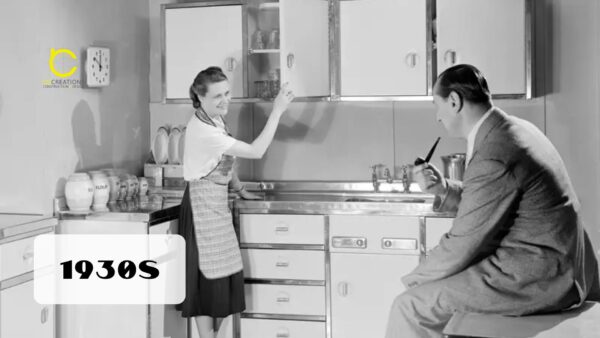
The 1940s:
The design of kitchens in the 1940s, heavily influenced by World War II and its aftermath, saw the impact of design, materials, and priorities throughout the country. Here are a couple of features notable during that time.
Utility and Conservation: During World War II, there was a strong emphasis on utility and conservation due to rationing and shortages of materials. Kitchen renovations focused on practicality and efficiency rather than luxury. Design elements were often simplified, with an emphasis on functionality. For example, cabinets were usually made of basic, inexpensive materials like plywood or metal, and decorative features were minimized or eliminated.
Integration of Labor-Saving Appliances: While the war limited materials and resources, it also accelerated technological advancements, particularly in kitchen appliances. Renovations in the 1940s often included integrating labor-saving appliances such as electric refrigerators, stoves, and washing machines. These appliances were becoming more commonplace in households, and designers adapted kitchen designs to accommodate them, with built-in spaces and connections for easy installation. Overall, kitchen renovations in the 1940s reflected the practicalities of wartime life, focusing on utility, conservation, and the integration of modern appliances to make household tasks more manageable despite the era’s challenges.

The 1950s:
The 1950s saw kitchen designs heavily influenced by post-war prosperity, technological advancements, and changing social dynamics. Here are a couple of features notable during that time
Bright and Colorful Aesthetics: The 1950s embraced a vibrant and cheerful aesthetic in kitchen design. Pastel colors like mint green, pale yellow, and baby blue were famous for kitchen cabinets, walls, and appliances. Renovations often incorporate these bright colors to create a cheerful and inviting atmosphere. Additionally, colorful linoleum or checkerboard tile flooring became a hallmark of 1950s kitchens, adding to the lively aesthetic.
Efficient Workspaces and Modern Appliances: The 1950s saw a continuation of the trend towards efficiency and modernity in kitchen design. Renovations often focused on creating efficient workspaces with ample storage and counter space. Built-in cabinetry with sleek, minimalist designs became more common, providing convenient storage for kitchen utensils and supplies. Integrating modern appliances such as electric refrigerators, dishwashers, and automatic coffee makers transformed kitchens into more efficient and functional spaces.
Overall, kitchen renovations in the 1950s embraced a cheerful, modern aesthetic while prioritizing efficiency and convenience. The era marked a significant shift towards using colorful design elements and integrating modern appliances, reflecting the optimism and prosperity of the post-war period.
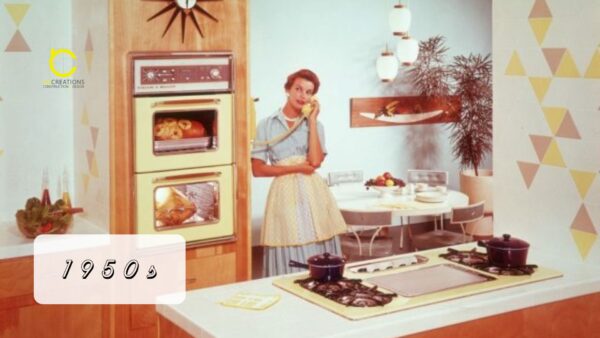
The 1960s:
Kitchen renovations in the 1960s, characterized by the evolving cultural and technological landscape of the time, saw an even more modern aesthetic and desire to open the living space to the kitchen. Here are a couple of features notable during that era.
Sleek and Minimalist Design: The 1960s witnessed a shift towards sleek and minimalist design aesthetics in kitchens. Clean lines, geometric shapes, and simple forms characterized the design of cabinetry and appliances. Renovations often involved using materials like laminate, stainless steel, and vinyl for countertops and cabinets, contributing to a modern and streamlined look.
Open-Concept Layouts: The 1960s saw a growing interest in open-concept living spaces, and kitchen renovations often reflected this trend. Designers removed walls to create open layouts that integrated the kitchen with adjacent living or dining areas. This layout allowed for a better flow of space and enhanced social interaction, aligning with the changing lifestyle preferences of the era.
Innovations in Appliances: The 1960s marked continued advancements in kitchen technology by introducing new and improved appliances. Renovations often included the installation of innovative appliances such as self-cleaning ovens, microwave ovens, and garbage disposals. These appliances made kitchen tasks even more convenient and reflected the increasing reliance on technology daily. Overall, kitchen renovations in the 1960s embraced sleek, minimalist design aesthetics, open-concept layouts, and the integration of innovative appliances, reflecting the cultural and technological shifts of the era.
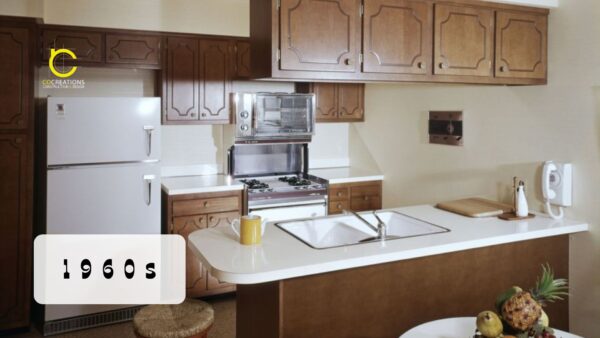
The 1970s:
The new social-political climate had a major influence on renovations in the 1970s by various factors, including changing social dynamics, technological advancements, and design trends.
Earth Tones and Natural Materials: The 1970s saw a shift towards earthy and natural design elements in kitchens. Renovations often incorporated warm earth tones such as browns, oranges, and harvest gold, reflecting the era’s emphasis on natural aesthetics. Designers commonly used natural materials like wood paneling, brick accents, and terracotta tiles to create a cozy and rustic atmosphere in kitchens.
Casual and Informal Layouts: Unlike previous decades’ formal and structured layouts, kitchen renovations in the 1970s often embraced a more casual and organic approach. Open shelving, freestanding furniture, and breakfast bars were popular design features that encouraged a relaxed and friendly atmosphere in the kitchen. Renovations focused on creating spaces conducive to gatherings and informal entertaining, reflecting the changing lifestyle preferences of the era. Overall, kitchen renovations in the 1970s embraced earthy design elements, casual layouts, and a focus on creating cozy and inviting spaces for socializing and gathering.
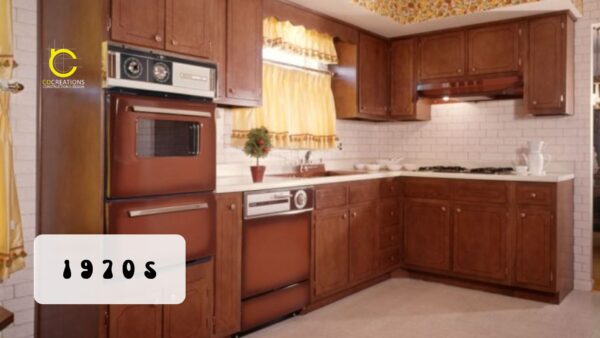
The 1980s:
Kitchen renovations in the 1980s continued to be focused on open-concept as well as adopting a take on a more traditional space. A mix of bold design choices, technological advancements, and a focus on functionality also characterized the design.
High-Tech Appliances: The 1980s saw significant advancements in kitchen technology, leading to the introduction of high-tech appliances. Renovations often included the installation of state-of-the-art appliances such as microwave ovens, convection ovens, and built-in coffee makers. Additionally, appliances with sleek designs and modern finishes became popular for homeowners looking to achieve a contemporary look in their kitchens.
Contemporary Design Trends: The 1980s embraced bold and eclectic design trends characterized by vibrant colors, geometric patterns, and high-gloss finishes. Renovations often incorporated these elements through colorful laminate countertops, glossy cabinets, and bold accent walls. Additionally, mirrored backsplashes and metallic accents were popular design features that added a touch of glamor to kitchen spaces. Overall, in the 1980s, kitchen renovations were defined by high-tech appliances, contemporary design trends, and a reflection of the era’s technological advancements and design preferences.
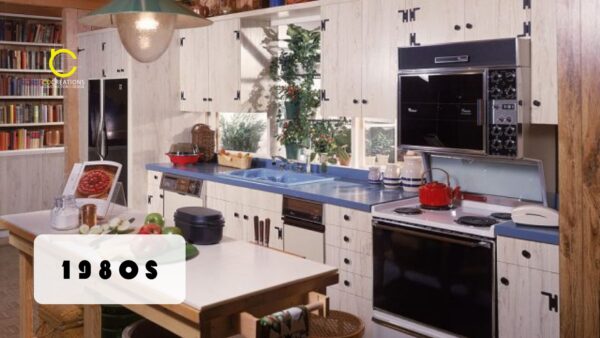
The 1990s:
Influenced by new design trends, technological advancements, and changing lifestyle preferences, kitchen renovations in the 1990s.
Neutral Color Palettes: The 1990s saw a shift towards more neutral color palettes in kitchen design. White, beige, and light gray became popular for cabinets, countertops, and walls. These neutral tones created a timeless, clean look that appealed to many homeowners. Sleek and Minimalist Design: Inspired by the minimalist design trends of the late 20th century, kitchen renovations in the 1990s often embraced sleek and streamlined aesthetics. Flat-panel cabinets with simple hardware, clean lines, and uncluttered surfaces were standard features in renovated kitchens. This minimalist approach created a sense of openness and modernity in the space.
Integration of Technology: The 1990s marked a period of rapid technological advancement, and kitchen renovations often incorporated the latest innovations in kitchen appliances and electronics. Built-in appliances such as microwaves, dishwashers, and ovens were seamlessly integrated into cabinetry to create a streamlined look. Additionally, advancements in lighting technology led to the widespread adoption of recessed and under-cabinet lighting, adding functionality and ambiance to the kitchen space. Overall, neutral color palettes, sleek minimalist design, and the integration of advanced technology influenced kitchen renovation trends of the 1990s, reflecting the era’s design trends and technological advancements.
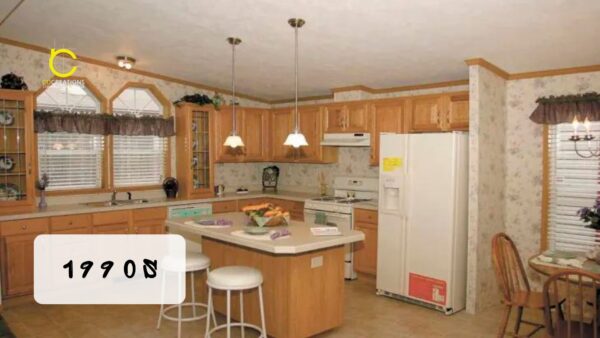
The 2000s:
The characteristics of the new millennium and growing sustainability trends influenced kitchen renovations in the early 2000s. There was a heavy emphasis on a mix of technological advancements and lifestyle preferences that altered the layout and design of the space.
Granite Countertops: Granite countertops became increasingly popular in kitchen renovations during the early 2000s. Granite offered durability, a wide range of color options, and a luxurious appearance, making it a sought-after choice for homeowners upgrading their kitchens. Renovations often involved replacing old laminate or tile countertops with sleek granite surfaces, adding style and functionality to the space.
Stainless Steel Appliances: The early 2000s saw the continued popularity of stainless steel appliances in kitchen renovations. Stainless steel appliances became synonymous with modernity and sophistication, and many homeowners opted to upgrade their kitchens with stainless steel refrigerators, dishwashers, ovens, and microwaves. The sleek and uniform appearance of stainless steel appliances added a cohesive and contemporary look to kitchen spaces. Overall, kitchen renovations in the early 2000s saw a shift in design influenced by the widespread adoption of granite countertops and stainless steel appliances, reflecting the era’s design trends and lifestyle preferences.
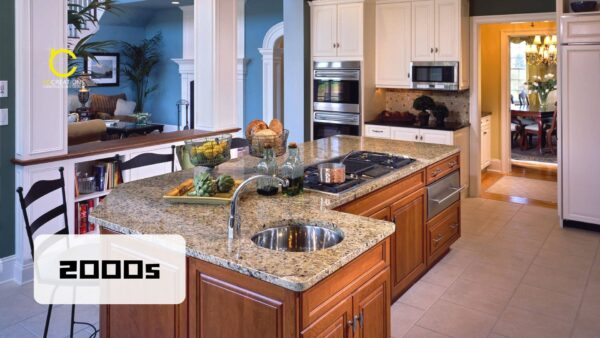
The 2010s:
Kitchen renovations in the 2010s saw a blend of modern design trends, technological innovations, and a focus on sustainability.
Quartz Countertops: Quartz countertops surged in popularity during the 2010s. They offered several advantages over traditional materials like granite, including durability, low maintenance, and a wide range of colors and patterns. Many homeowners opted for quartz countertops in their kitchen renovations due to their sleek appearance and practicality.
Smart Appliances and Technology Integration: The 2010s witnessed the rise of smart appliances and technology integration in kitchen renovations. From smart refrigerators with touchscreen displays to voice-controlled faucets and connected cooking appliances. Homeowners in the 2010s increasingly sought out kitchen innovations that offered convenience, efficiency, and connectivity. These intelligent features allow for remote monitoring, energy efficiency, and personalized control, reflecting the growing influence of technology in everyday life.
Open Shelving and Minimalist Design: The trend towards open shelving and minimalist design gained momentum in the 2010s. Many kitchen renovations embraced clean lines, uncluttered surfaces, and simplified cabinetry to create a minimalist aesthetic. Open shelving became a popular choice for displaying dishes, cookware, and decorative items, adding a touch of warmth and personality to the space and enhancing accessibility.
Sustainable Materials and Practices: Sustainability emerged as a critical consideration in kitchen renovations during the 2010s. Homeowners increasingly sought eco-friendly materials such as reclaimed wood, bamboo, and recycled glass for countertops, flooring, and cabinetry. Energy-efficient appliances, LED lighting, and water-saving fixtures were standard features in environmentally-conscious kitchen renovations. Started by a growing awareness of environmental issues and a desire to reduce carbon footprints.
Overall, kitchen renovations in the 2010s saw an increase in the widespread adoption of quartz countertops, intelligent appliances, technology integration, minimalist design aesthetics. They also had a focus on sustainability, reflecting homeowners’ evolving tastes, priorities, and lifestyle preferences during that decade.

The 2020s:
Kitchen renovations in the 2020s were influenced by the evolving lifestyles and technological advancements of the time, just as they were a century ago.
Smart Kitchen Technology Integration: The 2020s have continuously emphasized integrating innovative smart technology into kitchen renovations. This includes voice-activated assistants, smart appliances, and connected devices that offer convenience, efficiency, and remote control capabilities. Smart refrigerators with built-in touchscreens, Wi-Fi-enabled ovens, and automated faucets are popular additions to modern kitchens.
Multi-Functional Spaces: With the increasing popularity of open-concept living, kitchen renovations often focus on creating multi-functional spaces. These more modern kitchens serve as cooking areas, social hubs, and workspaces. Kitchen islands became a place that could accommodate seating for dining and entertaining and provide additional storage and workspace. Flexible layouts that adapted to various daily activities became highly sought after.
Sustainable Design and Materials: Environmental consciousness continues to shape kitchen renovations in the 2020s. Homeowners increasingly opt for eco-friendly materials such as bamboo, reclaimed wood, and recycled glass for countertops, cabinets, and flooring. Energy-efficient appliances, LED lighting, and water-saving fixtures are also commonly integrated into kitchen designs, reflecting a commitment to sustainability and reducing environmental impact.
Streamlined and Minimalist Aesthetics: Clean lines, minimalist design, and clutter-free spaces remain popular in kitchen renovations of the 2020s. Sleek cabinetry with integrated handles, hidden storage solutions, and unobtrusive hardware contribute to a contemporary and streamlined look. Neutral color palettes with occasional pops of color or natural elements create a timeless and inviting atmosphere in modern kitchens.
Health and Wellness Features: With an increased focus on health and wellness, kitchen renovations often incorporate features that promote a healthier lifestyle. These features included indoor air purification systems, water filtration systems, and dedicated spaces for growing herbs or vegetables. Additionally, ergonomic design elements such as adjustable-height countertops and easy-to-reach storage enhance comfort and accessibility in the kitchen. These are some of the prominent features and trends observed in kitchen renovations in the early years of the 2020s. They often reflect homeowners’ evolving needs, preferences, and values in the modern era.




